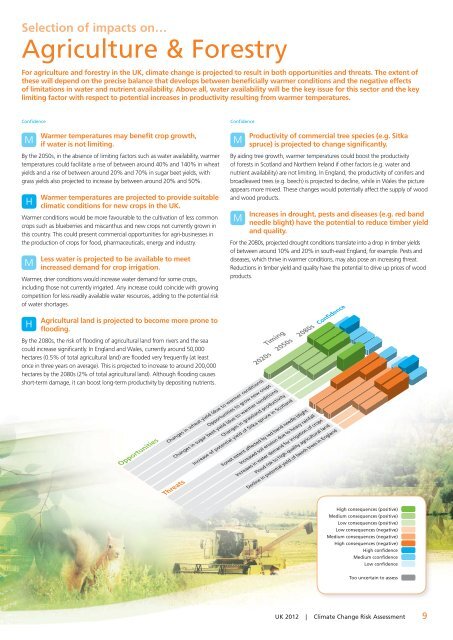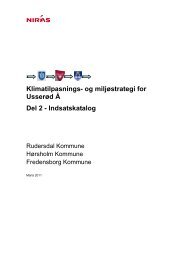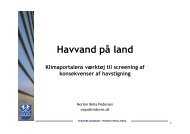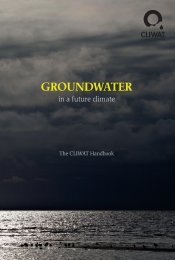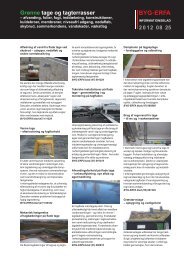Summary of key findings from the CCRA - Defra
Summary of key findings from the CCRA - Defra
Summary of key findings from the CCRA - Defra
You also want an ePaper? Increase the reach of your titles
YUMPU automatically turns print PDFs into web optimized ePapers that Google loves.
Selection <strong>of</strong> impacts on…<br />
Agriculture & Forestry<br />
For agriculture and forestry in <strong>the</strong> UK, climate change is projected to result in both opportunities and threats. The extent <strong>of</strong><br />
<strong>the</strong>se will depend on <strong>the</strong> precise balance that develops between beneficially warmer conditions and <strong>the</strong> negative effects<br />
<strong>of</strong> limitations in water and nutrient availability. Above all, water availability will be <strong>the</strong> <strong>key</strong> issue for this sector and <strong>the</strong> <strong>key</strong><br />
limiting factor with respect to potential increases in productivity resulting <strong>from</strong> warmer temperatures.<br />
Confidence<br />
Confidence<br />
M<br />
Warmer temperatures may benefit crop growth,<br />
if water is not limiting.<br />
M<br />
Productivity <strong>of</strong> commercial tree species (e.g. Sitka<br />
spruce) is projected to change significantly.<br />
By <strong>the</strong> 2050s, in <strong>the</strong> absence <strong>of</strong> limiting factors such as water availability, warmer<br />
temperatures could facilitate a rise <strong>of</strong> between around 40% and 140% in wheat<br />
yields and a rise <strong>of</strong> between around 20% and 70% in sugar beet yields, with<br />
grass yields also projected to increase by between around 20% and 50%.<br />
H<br />
Warmer temperatures are projected to provide suitable<br />
climatic conditions for new crops in <strong>the</strong> UK.<br />
Warmer conditions would be more favourable to <strong>the</strong> cultivation <strong>of</strong> less common<br />
crops such as blueberries and miscanthus and new crops not currently grown in<br />
this country. This could present commercial opportunities for agri-businesses in<br />
<strong>the</strong> production <strong>of</strong> crops for food, pharmaceuticals, energy and industry.<br />
M<br />
Less water is projected to be available to meet<br />
increased demand for crop irrigation.<br />
Warmer, drier conditions would increase water demand for some crops,<br />
including those not currently irrigated. Any increase could coincide with growing<br />
competition for less readily available water resources, adding to <strong>the</strong> potential risk<br />
<strong>of</strong> water shortages.<br />
By aiding tree growth, warmer temperatures could boost <strong>the</strong> productivity<br />
<strong>of</strong> forests in Scotland and Nor<strong>the</strong>rn Ireland if o<strong>the</strong>r factors (e.g. water and<br />
nutrient availability) are not limiting. In England, <strong>the</strong> productivity <strong>of</strong> conifers and<br />
broadleaved trees (e.g. beech) is projected to decline, while in Wales <strong>the</strong> picture<br />
appears more mixed. These changes would potentially affect <strong>the</strong> supply <strong>of</strong> wood<br />
and wood products.<br />
M<br />
Increases in drought, pests and diseases (e.g. red band<br />
needle blight) have <strong>the</strong> potential to reduce timber yield<br />
and quality.<br />
For <strong>the</strong> 2080s, projected drought conditions translate into a drop in timber yields<br />
<strong>of</strong> between around 10% and 20% in south-east England, for example. Pests and<br />
diseases, which thrive in warmer conditions, may also pose an increasing threat.<br />
Reductions in timber yield and quality have <strong>the</strong> potential to drive up prices <strong>of</strong> wood<br />
products.<br />
H<br />
Agricultural land is projected to become more prone to<br />
flooding.<br />
By <strong>the</strong> 2080s, <strong>the</strong> risk <strong>of</strong> flooding <strong>of</strong> agricultural land <strong>from</strong> rivers and <strong>the</strong> sea<br />
could increase significantly. In England and Wales, currently around 50,000<br />
hectares (0.5% <strong>of</strong> total agricultural land) are flooded very frequently (at least<br />
once in three years on average). This is projected to increase to around 200,000<br />
hectares by <strong>the</strong> 2080s (2% <strong>of</strong> total agricultural land). Although flooding causes<br />
short-term damage, it can boost long-term productivity by depositing nutrients.<br />
High consequences (positive)<br />
Medium consequences (positive)<br />
Low consequences (positive)<br />
Low consequences (negative)<br />
Medium consequences (negative)<br />
High consequences (negative)<br />
High confidence<br />
Medium cconfidence<br />
Low confidence<br />
Too uncertain to assess<br />
UK 2012 | Climate Change Risk Assessment 9


